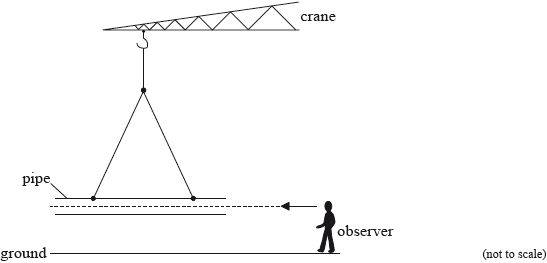| Date | May 2014 | Marks available | 3 | Reference code | 14M.2.HL.TZ2.4 |
| Level | Higher level | Paper | Paper 2 | Time zone | Time zone 2 |
| Command term | Outline | Question number | 4 | Adapted from | N/A |
Question
This question is about waves.
The diagram represents a standing (stationary) wave in air in a pipe which is open at both ends.

Two points in the pipe are labelled P and Q.
(i) State the direction of oscillation of an air molecule at point P.
(ii) Compare the amplitude of oscillation of an air molecule at point P with that of an air molecule at point Q.
A hollow pipe open at both ends is suspended just above the ground on a construction site.

Wind blows across one end of the pipe. This causes a standing wave to form in the air of the pipe, producing the first harmonic. The pipe has a length of 2.1 m and the speed of sound in air is \(330{\text{ m}}\,{{\text{s}}^{ - 1}}\).
Estimate the frequency of the first harmonic standing wave.
The pipe is held stationary by the crane and an observer runs towards the pipe. Outline how the frequency of the sound measured by the observer is different from the frequency of the sound emitted by the pipe.
Markscheme
(i) along axis of pipe / horizontal / left to right;
Do not allow “right” or “left” alone. Allow correct answers that appear on the diagram.
(ii) P has greater/maximum amplitude;
Q does not move/has zero amplitude;
\(\lambda = 4.2{\text{ m}}\);
79 or 78.6 (Hz); (do not allow 78 Hz)
Award [2] for a bald correct answer.
wavefronts emitted by the pipe at regular time intervals;
observer crosses the wavefronts more often than if stationary;
so frequency is higher;
Award [0] for a bald correct answer.
or
observer moving towards the source measures the emitted wavelength;
but (relative) wave speed measured is higher than that emitted;
so frequency is higher;
Award [0] for a bald correct answer.
or
quotes Doppler equation correctly;
deduces higher frequency correctly;
Award [2 max] for this approach.
Examiners report
(i) Most candidates were imprecise in their descriptions of the direction of motion of the air molecule. Very many think that the conventional diagram for the standing sound wave in a gas shows that the molecules move between the drawn lines of the wave. Answers such as “vertical” were common. Other inadequate responses featured “to the right” without the candidate realising that this implies that a molecule moves continually to the right eventually leaving the tube.
(ii) Descriptions of the amplitudes at P and Q were better but for a minority of candidates there was confusion between the meaning of node and antinode.
Calculations were generally well done.
This question was an “outline” and required a more sophisticated approach than “it is caused by the Doppler effect”. Examiners were looking for a description of the causes of the change in wavelength as perceived by the moving observer. Explanations that quoted a Doppler equation (it had to be the correct one) and deduced an increase in frequency were not awarded full marks as this is little more than copying by rote from the data booklet.

